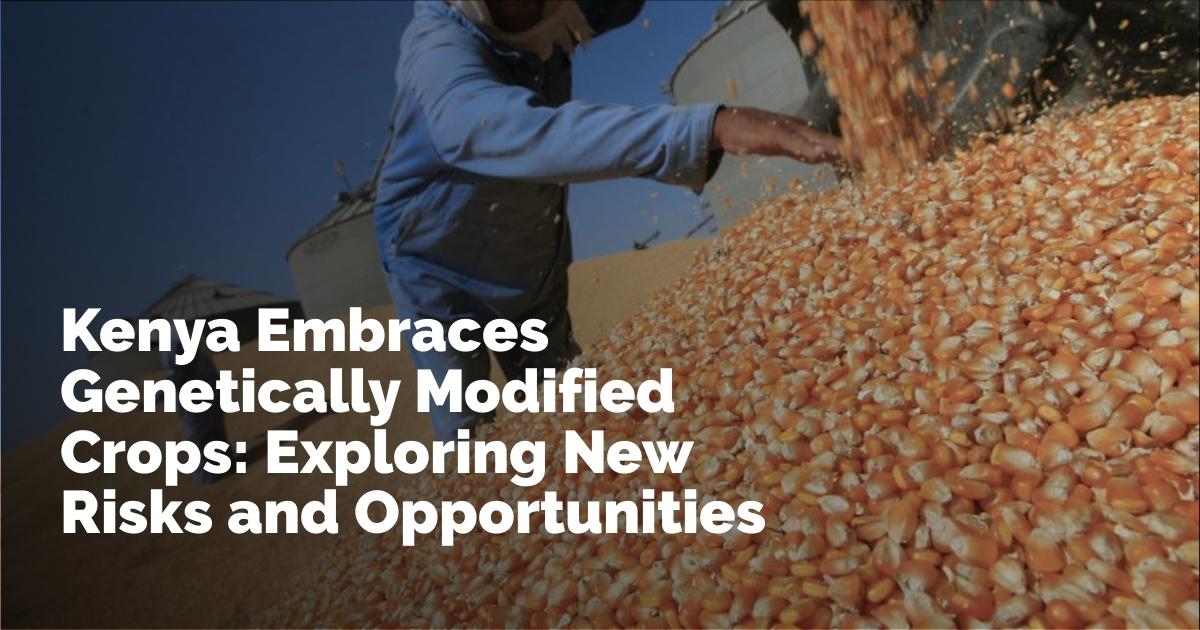Kenya's Strategic Move: Lifting the Ban on GMOs
In a significant and controversial policy shift, Kenya has lifted its embargo on genetically modified (GM) crops, a decision intrinsically linked to the country's dire food shortage issues exacerbated by the most severe drought in four decades and exponentially rising food prices. This recalibration of policy, which encompasses the prodigious white maize, Kenya's staple food, has been largely welcomed by scientists who advocate for GM crops as a path towards enhanced food security. Conversely, the decision has faced staunch opposition from environmentally conscious groups concerned about potential health and ecological repercussions. Here, we delve into the multifaceted debate surrounding this pivotal move, with insights from Benard Odhiambo Oloo, an expert in food safety and quality.
Understanding Genetically Modified Organisms (GMOs)
Genetically modified organisms (GMOs) encompass plants, microbes, or animals whose genetic structure has been altered through the incorporation of selected genes from unrelated species. This genetic engineering targets desired traits like higher yields, increased insect resilience, or enhanced drought resistance, among others. The process involves selecting and transferring genes responsible for specific traits to modify another organism's genes.
Historically, humans have enhanced domesticated crops' quality via conventional breeding, which propagates significant traits through successive generations. This traditional method typically spans 10-15 years. In contrast, genetic engineering can achieve similar objectives in less than five years. However, commercializing GM crops involves stringent regulations that often prolong their introduction, particularly in Africa, where the development pipeline stretches over decades.
The Slow Adoption of GMOs in Africa
Africa's acceptance of GMOs has been cautiously paced, with only a handful of nations permitting their commercialization. South Africa stands out as an early adopter, with over a decade of experience in GMO cultivation. By 2022, the number of African countries cultivating GM crops swelled from three in 2016 to ten. Apart from South Africa, nations such as Egypt, Sudan, Ethiopia, Burkina Faso, Malawi, Nigeria, Ghana, and eSwatini have sanctioned GM seed planting. Several other African countries are at various stages of developing and commercializing GMOs.
Kenya, Malawi, Uganda, Nigeria, Ghana, and others are exploring GM cotton resistant to African bollworm, GM cassava resilient to cassava brown streak disease, and GM maize impervious to stem borer. This year, Ghana greenlighted the release of pod borer resistant cowpea, marking its first foray into GM crop approval.
In 2019, Kenya authorized GMO cotton commercialization. Despite drought conditions, Kenyan farmers have reported favorable yields from Bt cotton after over two growing seasons. Across the continent, other farmers have reported substantial reductions in production costs due to lowered pest control needs, particularly the cost-intensive management of African bollworm infestations in cotton farming.
While the list of African nations embracing GMO cultivation is expected to expand, many continue to grapple with prolonged delays rooted in regulatory, political, and social hurdles.
Historical Context: Kenya's Ban on GMOs
Kenya instituted a GM crop ban in 2012, largely based on a controversial scientific study known as the Séralini study, which linked GMOs to cancer in rats. Activists opposing GMOs frequently cite this report and raise concerns about the unknown impacts of genetic modifications. Concerns extend to the potential health risks, European Union's wavering positions on GM food safety, and perceived threats to ecological diversity and the environment.
Critics also worry about the effects of GM crops on non-target organisms and the possibility of resistance development in insect pests. Persistent food safety fears compound these issues.
Several developments prompted the Kenyan government's policy reversal. Firstly, a task force report on genetically modified food outlined rigorous scientific regulation and underscored the presence of a robust regulatory framework. Secondly, food insecurity arising from severe droughts impacted over four million Kenyans, compelling the government to consider radical solutions. Consequently, Kenya now evaluates GMO introductions on a case-by-case basis.
Balancing Risks and Mitigations
The potential pitfalls of GMOs are threefold: unforeseen harmful effects, food safety concerns, and environmental safety issues—alongside social attitudes and fears of human overreach in natural processes.
Environmental Concerns: There's apprehension about GMOs' unintended environmental impacts. To mitigate these risks, GMO scientists have devised comprehensive regulations to ascertain GMOs' safety for humans and the environment, akin to conventional counterparts, before commercialization.
Food Safety: Regulatory authorities mandate rigorous food safety evaluations, including allergenicity testing, for GMOs before their market introduction. Many countries have established biosafety authorities to oversee GMO development and commercialization closely.
Environmental Safety: An internationally ratified framework governs GMOs' handling, conveying, and utilization, prescribing a detailed roadmap for assessing environmental impacts. It mandates post-release monitoring for at least a decade following a GM crop's introduction.
One particular environmental concern involves "super weeds" developing resistance to specific herbicides. While herbicide tolerance helps reduce GM crop production costs by enabling resistance to common herbicides like glyphosate, over-reliance on this method could eventually lead to resistant weed strains.
Mitigation Strategies: Farmers should employ integrated pest management systems, blending various weed and pest control techniques to preclude resistance development. In Kenya, local governments are tasked with early resistance detection, utilizing agricultural extension officers for surveillance and intervention.
Socio-cultural Dimensions: Addressing public concerns about GMOs is paramount. Governments must highlight humans' long history of crop modification. Additionally, GM foods, now cultivated and consumed globally for over two decades, lack scientific evidence supporting publicized fears. Evaluations consistently indicate GM crops are as safe for human consumption and environmental welfare as conventional crops.
Conclusion: Navigating the Future of Agriculture in Kenya
Kenya's decision to lift the GM crop ban reflects a response to urgent resource challenges and signifies a transformative shift towards modern agricultural practices. As the country navigates this new terrain, it faces the task of balancing technological advancement with health, environmental, and social considerations. Ensuring transparent and informed decision-making and fostering public trust will be essential as Kenya aims to bolster food security and adapt to evolving climatic and economic contingencies.
출처 : Original Source

